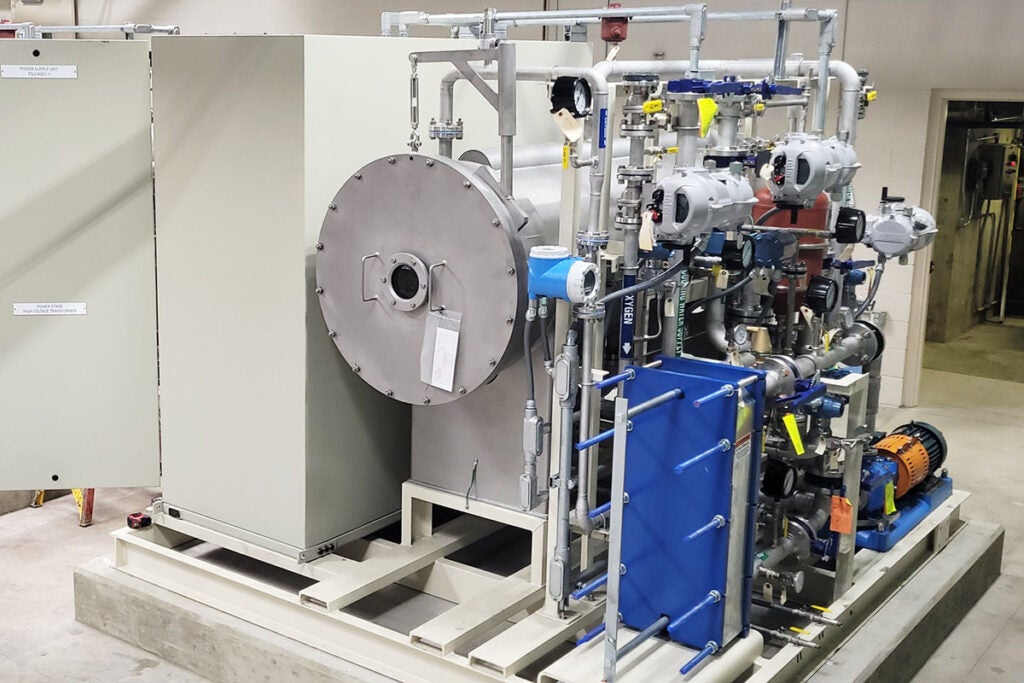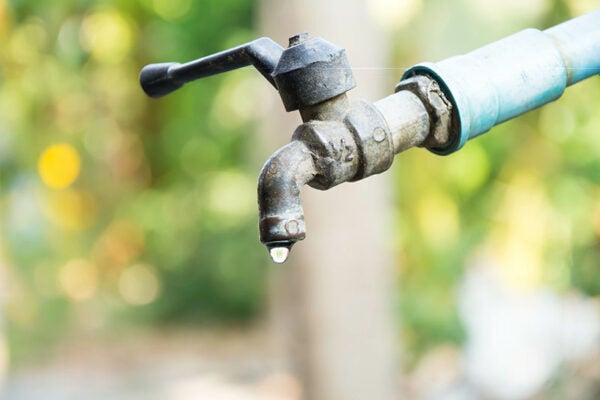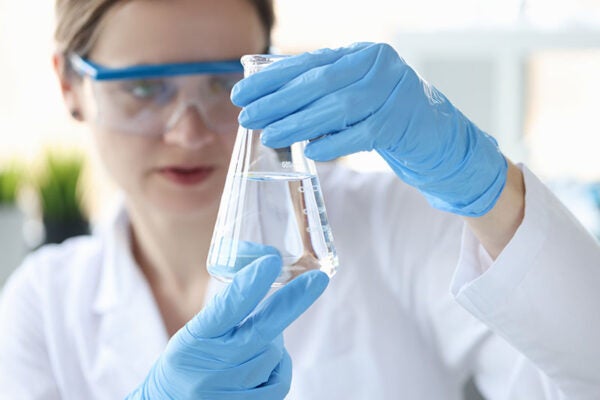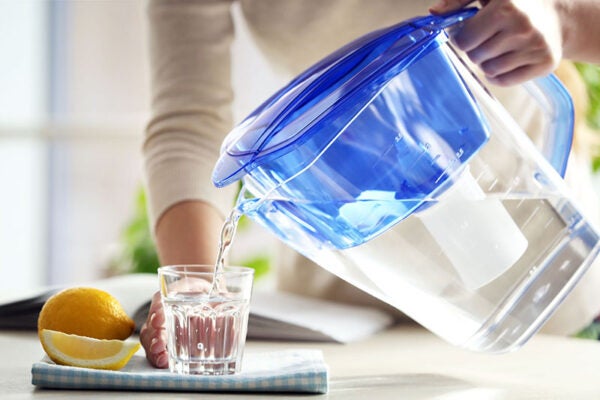Click the links above to learn more about water quality issues. Have questions about water quality? You’ll find answers to our frequently asked questions below. If it doesn’t answer your question, give us a call at 541-774-2430, and we’ll be happy to help.
Where does our water come from?

During the winter months, our drinking water comes from Big Butte Springs. In the summer, water is supplemented from the Rogue River. For more information on these sources, visit our Water Resources page.
What is the Safe Drinking Water Act, and how does it protect consumers?

For the hundreds of millions of water consumers in the United States, the Safe Drinking Water Act ensures that water quality standards are the same throughout the country. It identifies potential constituents in drinking water and sets safe limits for each of them.
How does Medford Water make sure our water meets Safe Drinking Water standards?

Every month, Medford Water staff members collect and analyze hundreds of water samples from throughout the system. In fact, we test even more frequently and extensively than the Environmental Protection Agency (EPA) mandates. The Safe Drinking Water Act requires water purveyors to test for nearly 100 chemicals, radiological and bacteriological contaminants—but we even look for things that are not regulated. Compounds like perchlorate and MTBE—a gasoline additive—are not regulated by either the State of Oregon or the EPA, but we monitor levels on an ongoing basis.
If the water meets federal and state standards, why is there so much media coverage about contaminants?

All drinking water—even bottled water—contains some level of contaminants. However, these naturally occurring and artificial materials do not necessarily present a health risk. While news reports about water quality are generally accurate, they do not always convey their risk level. For instance, a contaminant may be harmful only if a person consumes hundreds of gallons of water a day. For detailed information about contaminants and potential health effects, consumers can call the EPA’s Safe Drinking Water Hotline at (800) 426-4791.
How is tap water treated?

Big Butte Springs water is treated only with disinfection; water from the Rogue River is first treated with disinfection and ozonation to kill any potentially harmful bacteria and microscopic organisms. It then moves through a direct filtration process to remove any particles. For more information on the treatment process, go to our Treatment Process page.
Is our water considered hard or soft, and what is the pH?

Big Butte Springs and Rogue River water are very similar in chemical characteristics; both are classified as moderately soft, typically ranging between 25 and 40 ppm. Hardness is also sometimes given in grains per gallon, with our water generally having between 1.4 and 2.4 grains per gallon. The pH of water entering our drinking water system from Big Butte Springs is approximately 7.0, and 7.3 for the water entering from the Rogue River, which are both fairly neutral.
What can I do to improve my water quality?

Always use the cold water tap for drinking or cooking, since hot water is more likely to release metals from your pipe materials.
During periods of long stagnation, water can pick up off-tastes from sitting in the plumbing inside of your house, especially in older plumbing systems. To help combat this, you can run your water for 30 seconds to 2 minutes (until you feel the temperature drop) before drinking or cooking, to flush water that has been sitting in pipes without use, such as: in the morning, after returning from work or school, and especially after a vacation. Conservation tip: When flushing water from pipes, you can reduce the length of time needed to run the tap if you run your sprinklers, wash a load of laundry, or shower first. Consider catching flushed tap water for plants or other household use, such as cleaning.
Periodically remove/clean the aerators in your faucet, filters for your refrigerator water supply, and filters in your water filtration pitchers if you choose to use them.
Are there any precautions the public should take?

People with weakened immune systems need to pay special attention to everything they consume. These immuno-compromised groups include people undergoing chemotherapy, people with HIV/AIDS or other immune system disorders, those who have undergone organ transplants, and some infants and elderly persons. These people should seek advice from their primary healthcare provider about any potential risks.
Does our water contain PFAS?

Per- and polyfluoroalkyl substances (PFAS) have not been detected in Medford’s drinking water. Find more information on PFAS on our PFAS page.
Does our water contain lead?

Our two water supplies—Big Butte Springs and the Rogue River—contain virtually no lead or copper. However, lead and copper can be released into the water from materials in private home plumbing and in the water system. In addition to the frequent water sampling we do at our source points and throughout our system, supplemental testing is conducted at the individual taps of customers whose private plumbing meets criteria for being at risk for elevated lead and copper levels.
The Environmental Protection Agency’s Lead and Copper Rule requires a water provider to take certain actions to reduce lead exposure if 10 percent of water samples return lead levels of over 15 parts per billion (ppb). In 2022, the 90th percentile value of our water was 1.1 ppb. Find out more on our Lead page.
Does Medford Water use chloramines?

No, only sodium hypochlorite is used for disinfection; ammonia is not added.
Have algal toxins been detected in our drinking water?

No, algal toxins have never been detected at our intake or in our finished drinking water since the statewide testing program began in 2018.
Is there a potential for contamination from volatile organic compounds (VOCs) following fire activity?

When returning to your home or business after a fire, there are items to consider to help safeguard your water quality.
During periods of long stagnation (such as a home being unoccupied for several days), water can pick up off-tastes, odors, or colors from sitting in the pipes inside your house, especially in older plumbing systems. To help combat this, open all cold water taps and run the water for 2-5 minutes to flush the “old” water out before using it for drinking or cooking.
In addition, fire can cause damage to water system plumbing, and plastic pipe materials are particularly susceptible to fire damage. In spite of Medford Water’s high-quality water supply, plastic pipe that is damaged by fire can release contamination in the form of volatile organic compounds (VOCs), such as Benzene, into the water. These compounds can cause the water to have an odor similar to gasoline and may have adverse health impacts at elevated concentrations.
If your home or business has plastic piping and has been damaged by fire, you may consider having your water tested by a state-certified laboratory. Neilson Research Corporation is the only certified independent water testing laboratory in our area; their phone number is (541) 770-5678. If you are not a Medford Water customer, contact your local jurisdictions to learn more about the pipe materials in your local water system.
Boiling will not remove these contaminants and should not be used as a barrier if you think you may be impacted with these issues.
For help, contact our Customer Service Department at (541) 774-2430 during normal business hours. Go to https://www.epa.gov/indoor-air-quality-iaq/what-are-volatile-organic-compounds-vocs for more information on VOCs.
Does Medford Water add fluoride to the water?

No, Medford Water does not add fluoride to the water.
Does Medford Water flow water from fire hydrants?

Yes. While we of course always want to avoid wasting water, our highest priority is assuring high water quality for our customers, which sometimes necessitates the flushing of pipes and hydrants. Learn more about hydrant flushing on our Hydrant Flushing page.
Is Naegleria fowleri found in our drinking water?

While the risk of Naegleria fowleri is low given our cold source waters, we understand that it may concern some customers. Medford Water’s first concern is the health and safety of our customers, and we have protective measures in place to prevent Naegleria fowleri and other potential contaminants from surviving in finished water, through disinfection and regularly flushing out portions of our distribution system (to keep water from sitting stagnant for long periods of time). To learn more about our disinfection practices, go to our Water Quality Information page.
If you are concerned about Naegleria fowleri, there are additional steps you can take to protect yourself and your family:
- First, it’s important to remember you cannot get infected from drinking water that is contaminated with Naegleria fowleri.Naegleria fowleri infects people when water containing the amoeba enters the body through the nose. The U.S. Centers for Disease Control advises that if you are making a solution for irrigating, flushing, or rinsing your sinuses (for example, by using a neti pot, sinus rinse bottle or other irrigation device), use water that has been:
- Previously boiled for 1 minute (at elevations above 6,500 feet, boil for 3 minutes) and left to cool, or
- Filtered, using a filter with an absolute pore size of 1 micron or smaller, or
- Purchased with a label specifying that it contains distilled or sterile water.
- Rinse the irrigation device after each use with water that has been previously boiled, filtered, distilled, or sterilized, then wipe the inside dry or leave the device open to air dry completely.
- To protect yourself from Naegleria fowleri-contaminated water, CDC further recommends:
- DO NOT allow water to go up your nose or sniff water into your nose when bathing, showering, washing your face, or swimming in small hard plastic/blow-up pools.
- DO NOT jump into or put your head under bathing water (bathtubs, small hard plastic/blow-up pools)—walk or lower yourself in.
- DO NOT allow children to play unsupervised with hoses or sprinklers, as they may accidentally squirt water up their nose. Avoid slip-n-slides or other activities where it is difficult to prevent water going up the nose.
- DO run bath and shower taps and hoses for 5 minutes before use to flush out the pipes. This is most important the first time you use the tap after the water utility raises the disinfectant level.
- DO keep small hard plastic/blow-up pools clean by emptying, scrubbing, and allowing them to dry after each use.
- DO use only boiled and cooled, distilled, or sterile water for making sinus rinse solutions for neti pots or performing ritual ablutions.
- DO keep your swimming pool adequately disinfected before and during use. Adequate disinfection means:
- Pools: free chlorine at 1-3 parts per million (ppm) and pH of 7.2-7.8
- Hot tubs/spas: free chlorine at 2-4 parts per million (ppm) or free bromine at 4-6 ppm and pH of 7.2-7.8
- If you need to top off the water in your swimming pool with tap water,
- DO place the hose directly into the skimmer box and ensure that the filter is running.
DO NOT top off by placing the hose in the body of the pool.
Why is our water treated with chlorine?

Drinking water must be disinfected to treat disease-causing microbial pathogens (e.g., bacteria, viruses, protozoa, parasites). Chlorine, in the form of sodium hypochlorite, is used as a disinfectant in our treatment process; we are required by drinking water standards to maintain a residual amount in the water to provide continuous protection from microbial contamination as it travels through our distribution system and to your tap. Sampling throughout the system confirms that the amount of chlorine present is neither too low nor too high per the limits set by the EPA. Our water is effectively disinfected with much less chlorine than the allowable limit.
What are Disinfection By-products (DBPs)?

Disinfection by-products (DBPs) are formed when a water treatment disinfectant, such as chlorine, interacts with natural organic materials in water. Exposure to DBPs occurs by drinking chlorinated water and by breathing in air containing DBPs during activities such as showering, bathing, dishwashing, and swimming.
Does Medford Water monitor for Disinfection By-products (DBPs)?

Disinfection by-products (DBPs) are formed when a water treatment disinfectant, such as chlorine, interacts with natural organic materials in water. We monitor for DBPs four times a year, and publish the results in our Consumer Confidence Report, which focuses on providing details about compliance with regulations. It is also published in our Annual Water Quality Analyses, which is a comprehensive listing of all of our annual testing results. Both of these documents are available on the Water Quality Reports page of our website.
Our DBP levels are below—and in compliance with—the regulations of maximum contaminant levels (MCLs) that the U.S. Environmental Protection Agency (EPA) and the Oregon Health Authority (OHA) have established to protect human health. However, if a violation occurs, we are required to inform our customers. If consumed in excess of the EPA’s MCLs over many years, DBPs may increase health risks.
What is Medford Water doing to reduce DBPs and improve water quality?

In addition to using less chlorine than the allowable limit to effectively disinfect our drinking water, our Source Water Protection Program works with land use managers and partners throughout the region and state, advocating the use of best management practices to reduce organic matter in our source water.
Over the years I’ve heard that bottled water is safer to drink and now someone is trying to sell me a home treatment device or filter for my tap water; is there a problem with my tap water?

Increasingly over the last several years, people have been bombarded with alarming sales pitches touting the benefits of bottled water and home treatment devices, causing people to question the quality of their tap water. There are no apparent health advantages for the general public in purchasing a home treatment system (most only affect the aesthetic qualities of tap water), with the possible exception of immuno-compromised individuals. It is strictly a personal decision that should be based on preference rather than fear.
Like most large public water supply systems, the water we deliver is of excellent quality, easily exceeding all federal and state health standards, and the vast majority of substances tested for are not found in our water even in minute quantities. In fact, while you will pay far more for bottled water, it is not subject to more stringent regulations, and may in fact be of lesser quality. Go to our Water Filters page for more information.
What is ozonation, and why is it used?

Ozone (O3) occurs in nature and can also be formed from oxygen, or oxygen compounds, in a variety of ways. Ozone is a powerful oxidant widely used in water treatment to kill bacteria and other organisms, and reduce taste, odors, and color. The inherent features of ozone are its high oxidation potential and disinfection capabilities. This, coupled with the fact that ozone decomposes to oxygen, and produces fewer disinfection by-products than chlorine, makes it an ideal choice for many water treatment applications.
Following years of treatment challenges attempting to control low-level tastes and odors in the Rogue River source, ozone emerged as the most promising treatment option, being highly successful at eliminating taste and odor causing compounds, while also providing other treatment benefits. Ozonation was added at the Robert A. Duff Water Treatment Plant in 2002. An overview of the process follows:

Storage and Vaporization
Oxygen is delivered to the treatment plant as liquid oxygen (LOX), where it is stored on site in an insulated pressure container. As the LOX is used, it passes through an ambient vaporizer where it is converted to gaseous oxygen (GOX). The oxygen is very clean and dry with a dew point of less than –95oC.
Ozone Generation
The GOX flows to the ozone generators for ozone production. Oxygen molecules (O2) travel through a discharge gap, which is around the devices called dielectrics, where they are subject to a high voltage corona discharge. Delivering high voltage to the dielectrics produces this discharge. While in the gap, some of the O2 molecules are separated into free oxygen atoms (O). It is these free oxygen atoms which combine with other O2 molecules to form ozone (O3).
Since this process does not convert all the oxygen molecules into ozone, the gas leaving the ozone generator contains only 10-12 percent. This percentage is a function of inlet gas flow rate, temperature, pressure, and power input to the ozone generator.
Heat accumulated by the ozone generation process is removed by cooling water. Cooling water passes around the cylindrical tubes, which house the dielectrics. This cooling process is crucial to the efficiency of ozone production since heat is a detriment to the formation of ozone.
Dissolution
The mixture of ozone and oxygen gas is carried to injection points on a side-stream flow of the raw water and then combined with the balance of the raw water as it enters the ozone contact basin.
The ozone is in contact with the water as it travels through the ozone contact basin and is consumed rapidly. Ozone has a measurable residual in the first chambers of the basin but by the time the water gets to the end the ozone residual is gone.
Ozone Destruction
There is a small portion of the ozone that does not go into solution and therefore reaches the headspace of the closed ozone contact basin. This ozone is drawn off by vacuum and passes through an ozone destruct catalyst, which converts the ozone back to oxygen, which is discharged.
Who can I call if I have any questions about water quality?

For information about water quality, call 541-774-2430. Questions also can be emailed to us or mailed to Medford Water, 200 S. Ivy St. – RM 177, Medford, OR 97501. The Environmental Protection Agency’s Safe Drinking Water Hotline can be reached at 800-426-4791.


